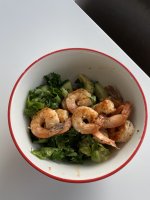nadellii
Active member
Today I marinated and cooked some shrimp Greek style. I chopped up some fresh garlic, squeezed lemon, and marinated shrimp with salt, pepper, parsley, oregano, and paprika. I cooked the shrimp very quickly on each side (about 2 minutes) so that it wouldn’t shrivel up if overcooked. I made a salad with lettuce, parsley, tomato, cucumber, and avocado! Such a great, healthy, and quick meal!




